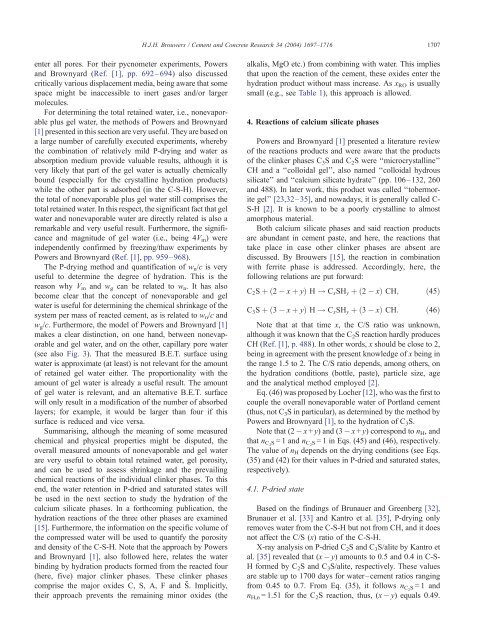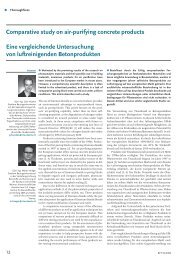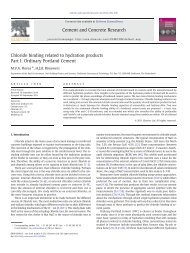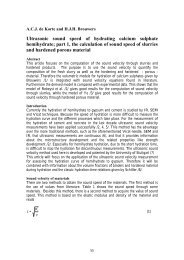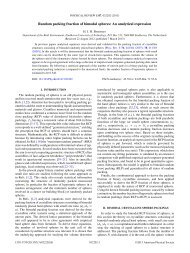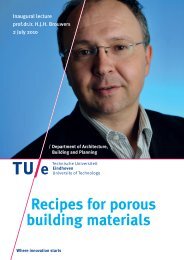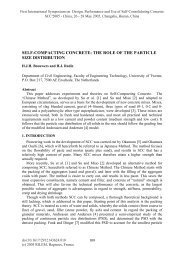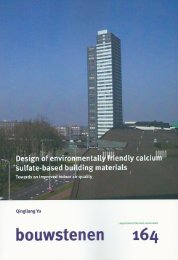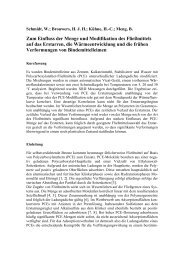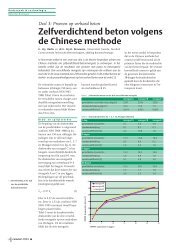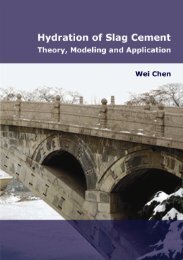The work of Powers and Brownyard revisited: Part 1 - Jos Brouwers
The work of Powers and Brownyard revisited: Part 1 - Jos Brouwers
The work of Powers and Brownyard revisited: Part 1 - Jos Brouwers
Create successful ePaper yourself
Turn your PDF publications into a flip-book with our unique Google optimized e-Paper software.
H.J.H. <strong>Brouwers</strong> / Cement <strong>and</strong> Concrete Research 34 (2004) 1697–1716 1707enter all pores. For their pycnometer experiments, <strong>Powers</strong><strong>and</strong> <strong>Brownyard</strong> (Ref. [1], pp. 692–694) also discussedcritically various displacement media, being aware that somespace might be inaccessible to inert gases <strong>and</strong>/or largermolecules.For determining the total retained water, i.e., nonevaporableplus gel water, the methods <strong>of</strong> <strong>Powers</strong> <strong>and</strong> <strong>Brownyard</strong>[1] presented in this section are very useful. <strong>The</strong>y are based ona large number <strong>of</strong> carefully executed experiments, wherebythe combination <strong>of</strong> relatively mild P-drying <strong>and</strong> water asabsorption medium provide valuable results, although it isvery likely that part <strong>of</strong> the gel water is actually chemicallybound (especially for the crystalline hydration products)while the other part is adsorbed (in the C-S-H). However,the total <strong>of</strong> nonevaporable plus gel water still comprises thetotal retained water. In this respect, the significant fact that gelwater <strong>and</strong> nonevaporable water are directly related is also aremarkable <strong>and</strong> very useful result. Furthermore, the significance<strong>and</strong> magnitude <strong>of</strong> gel water (i.e., being 4V m ) wereindependently confirmed by freezing/thaw experiments by<strong>Powers</strong> <strong>and</strong> <strong>Brownyard</strong> (Ref. [1], pp. 959–968).<strong>The</strong> P-drying method <strong>and</strong> quantification <strong>of</strong> w n /c is veryuseful to determine the degree <strong>of</strong> hydration. This is thereason why V m <strong>and</strong> w g can be related to w n . It has alsobecome clear that the concept <strong>of</strong> nonevaporable <strong>and</strong> gelwater is useful for determining the chemical shrinkage <strong>of</strong> thesystem per mass <strong>of</strong> reacted cement, as is related to w n /c <strong>and</strong>w g /c. Furthermore, the model <strong>of</strong> <strong>Powers</strong> <strong>and</strong> <strong>Brownyard</strong> [1]makes a clear distinction, on one h<strong>and</strong>, between nonevaporable<strong>and</strong> gel water, <strong>and</strong> on the other, capillary pore water(see also Fig. 3). That the measured B.E.T. surface usingwater is approximate (at least) is not relevant for the amount<strong>of</strong> retained gel water either. <strong>The</strong> proportionality with theamount <strong>of</strong> gel water is already a useful result. <strong>The</strong> amount<strong>of</strong> gel water is relevant, <strong>and</strong> an alternative B.E.T. surfacewill only result in a modification <strong>of</strong> the number <strong>of</strong> absorbedlayers; for example, it would be larger than four if thissurface is reduced <strong>and</strong> vice versa.Summarising, although the meaning <strong>of</strong> some measuredchemical <strong>and</strong> physical properties might be disputed, theoverall measured amounts <strong>of</strong> nonevaporable <strong>and</strong> gel waterare very useful to obtain total retained water, gel porosity,<strong>and</strong> can be used to assess shrinkage <strong>and</strong> the prevailingchemical reactions <strong>of</strong> the individual clinker phases. To thisend, the water retention in P-dried <strong>and</strong> saturated states willbe used in the next section to study the hydration <strong>of</strong> thecalcium silicate phases. In a forthcoming publication, thehydration reactions <strong>of</strong> the three other phases are examined[15]. Furthermore, the information on the specific volume <strong>of</strong>the compressed water will be used to quantify the porosity<strong>and</strong> density <strong>of</strong> the C-S-H. Note that the approach by <strong>Powers</strong><strong>and</strong> <strong>Brownyard</strong> [1], also followed here, relates the waterbinding by hydration products formed from the reacted four(here, five) major clinker phases. <strong>The</strong>se clinker phasescomprise the major oxides C, S, A, F <strong>and</strong> S¯. Implicitly,their approach prevents the remaining minor oxides (thealkalis, MgO etc.) from combining with water. This impliesthat upon the reaction <strong>of</strong> the cement, these oxides enter thehydration product without mass increase. As x RO is usuallysmall (e.g., see Table 1), this approach is allowed.4. Reactions <strong>of</strong> calcium silicate phases<strong>Powers</strong> <strong>and</strong> <strong>Brownyard</strong> [1] presented a literature review<strong>of</strong> the reactions products <strong>and</strong> were aware that the products<strong>of</strong> the clinker phases C 3 S <strong>and</strong> C 2 S were ‘‘microcrystalline’’CH <strong>and</strong> a ‘‘colloidal gel’’, also named ‘‘colloidal hydroussilicate’’ <strong>and</strong> ‘‘calcium silicate hydrate’’ (pp. 106–132, 260<strong>and</strong> 488). In later <strong>work</strong>, this product was called ‘‘tobermoritegel’’ [23,32–35], <strong>and</strong> nowadays, it is generally called C-S-H [2]. It is known to be a poorly crystalline to almostamorphous material.Both calcium silicate phases <strong>and</strong> said reaction productsare abundant in cement paste, <strong>and</strong> here, the reactions thattake place in case other clinker phases are absent arediscussed. By <strong>Brouwers</strong> [15], the reaction in combinationwith ferrite phase is addressed. Accordingly, here, thefollowing relations are put forward:C 2 S þð2 x þ yÞ H ! C x SH y þð2 xÞ CH; ð45ÞC 3 S þð3 x þ yÞ H ! C x SH y þð3 xÞ CH: ð46ÞNote that at that time x, the C/S ratio was unknown,although it was known that the C 2 S reaction hardly producesCH (Ref. [1], p. 488). In other words, x should be close to 2,being in agreement with the present knowledge <strong>of</strong> x being inthe range 1.5 to 2. <strong>The</strong> C/S ratio depends, among others, onthe hydration conditions (bottle, paste), particle size, age<strong>and</strong> the analytical method employed [2].Eq. (46) was proposed by Locher [12], who was the first tocouple the overall nonevaporable water <strong>of</strong> Portl<strong>and</strong> cement(thus, not C 3 S in particular), as determined by the method by<strong>Powers</strong> <strong>and</strong> <strong>Brownyard</strong> [1], to the hydration <strong>of</strong> C 3 S.Note that (2 x + y) <strong>and</strong> (3 x + y) correspond to n H , <strong>and</strong>that n C2 S = 1 <strong>and</strong> n C2 S = 1 in Eqs. (45) <strong>and</strong> (46), respectively.<strong>The</strong> value <strong>of</strong> n H depends on the drying conditions (see Eqs.(35) <strong>and</strong> (42) for their values in P-dried <strong>and</strong> saturated states,respectively).4.1. P-dried stateBased on the findings <strong>of</strong> Brunauer <strong>and</strong> Greenberg [32],Brunauer et al. [33] <strong>and</strong> Kantro et al. [35], P-drying onlyremoves water from the C-S-H but not from CH, <strong>and</strong> it doesnot affect the C/S (x) ratio <strong>of</strong> the C-S-H.X-ray analysis on P-dried C 2 S <strong>and</strong> C 3 S/alite by Kantro etal. [35] revealed that (x y) amounts to 0.5 <strong>and</strong> 0.4 in C-S-H formed by C 2 S <strong>and</strong> C 3 S/alite, respectively. <strong>The</strong>se valuesare stable up to 1700 days for water–cement ratios rangingfrom 0.45 to 0.7. From Eq. (35), it follows n C2 S = 1 <strong>and</strong>n H,n = 1.51 for the C 2 S reaction, thus, (x y) equals 0.49.


